Disclosure: We may earn commissions if you purchase products after clicking on a link from our site.
Fishing for tautog has become popular as it is exciting and it is good for eating. Tautog is difficult to catch as it is a bottom feeder and resides in structures, wrecks, jetties, rock pilings, reefs, etc. as it hides from predators as well as waits in ambush for its prey. Tautog can put up a fight and are known to break the line. They are also known to steal the bait from the hook. In this article, we share information and fishing techniques to help you learn how to catch tautog.

Table of Contents
How To Catch Tautog
1. How To Catch Tautog From A Boat
You can catch Tautog with a basic tackle using bait such as green crabs, Asian crabs, clams, and oysters. You fish for Tautog in a boat using basic saltwater bottom fishing. Use a light conventional rod and reel setup. With the bait on the line, set it close to the bottom around structures, rock piles, boulders, jetties, bridges, reefs, moorings, mussel beds, and wrecks and wait to get a strike.
Initially, it will feel like the rod is being scratched. The “scratching is the tautog teeth chewing on the bait. Be patient and don’t set the hook yet. Wait for several hard thumps to set the hook. You must wait for the tautog to get the bait past its front teeth and deeper into its mouth before you set the hook.
2. How To Catch Tautog From The Shore
When fishing for tautog from the shore, you can use a sliding sinker rig which is also known as the Carolina rig or fish finder rig. With this rig, the fish can take the bait and move off with it without feeling any resistance from the sinker. Use a 40-pound fluorocarbon leader and a #4/0 circle hook.
Tautog can be found in inshore waters and can be found in structures, rock piles, jetties, wrecks, docks, bridges, etc. Spinning tackle is the best option when you fish for tautog from the shore. It is easier to cast baits out accurately and over a distance with spinning tackle than with conventional tackle from the shore. A 7-foot medium action rod with a 4000-5000 series reel is a good combination.
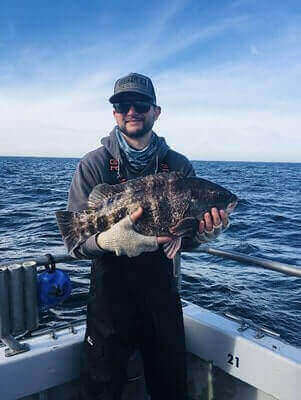
How To Catch Tautog Chesapeake Bay
When fishing for tautog in the Chesapeake Bay, look for wrecks, reefs, rock pilings, or other structures. Tautog uses these structures to hide as they wait in an ambush for prey. Tautog takes some time to get the bait past its front teeth and deeper into its mouth. This is key as you have to give it time before setting the hook. if you are too hasty, you will miss Tautog time and time again.
Blue crabs, squid, clams, mussels, and fiddler crabs are some of the bait used when fishing for tautog. A basic rig will work when fishing for tautog. Bottom fishing, casting, drift fishing, and still fishing can work when fishing for tautog.
How To Catch Tautog In Rhode Island
When fishing for tautog in Rhode Island, look for structures like rocks, wrecks, bridge piers, dock pilings, mussel beds, ledges, and humps. They will be near these structures where they prey on barnacles, mussels, seaworms, and green carbs. Bottom fishing, casting, and drift fishing are some of the fishing methods that are used when fishing for tautog in Rhode Island.
How To Catch Tautog In Maine
Tautog is found around wrecks, docks, rocks, boulders, and breakwaters. Drop your bait near these structures when fishing for tautog. Crabs, shrimp, clams, mussels, and marine worms are baits that can be used when fishing for tautog. Bottom fishing, drift fishing, and casting are often used when fishing for tautog.
Tautog Fishing Tips
1. Tautog are daytime feeders and become inactive at night.
2. Tautog is a bottom feeder.
3. Bring a cover or lid for the crabs and a pair of scissors to clip off the claws and legs. It is easier to thread a crab onto a hook with the claws and legs of the crabs removed.
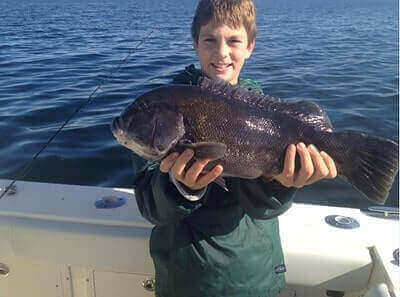
4. You can find Asian crabs for bait along the shoreline by turning over bowling-ball-sized rocks near the high tide mark. It might take anywhere from 30 to 60 minutes to fill a small bucket.
5. Trophy tog will move straight for a hole or structure when hooked. Therefore use a 20- to 30-pound braided line with a 50-pound fluorocarbon leader.
6. Larger tautogs hide in the dark holes of structures and wrecks waiting to ambush their prey as they swim by. Therefore, you need to fish in the structures or have baited hooks right next to hull breaches in the wreck.
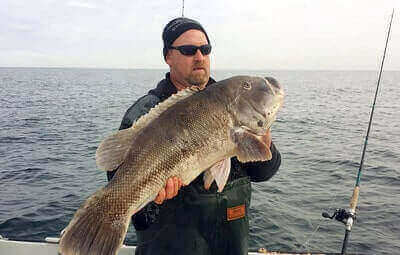
7. If you made a drop and after 15 minutes, there is no bite, move to another location.
8. From May to mid-June is the best time to go fishing for tautog. Additionally, the end of September to the end of October is also a good time to catch tautog. Spring and fall are the best for tautog fishing.
9. The daytime is the best time to go fishing for tautog.

10. Go fishing for tautog 3 hours before a high tide to 3 hours after the high tide.
11. Tautog likes to hide where there are smaller boulder fields, wrecks, break walls, pilings, jetties, reefs, and rocky slopes.
12. You can fish for tautog from the shore. Docks, jetties, and bridges are structures to search for tautog.

13. One of the best rigs for tautog is a high-low rig with a lead sinker.
14. When tautog fishing, many rigs will be lost. It’s just the price you pay to catch good-sized tautog. Always go prepared with extra rigs.
15. Use a wreck anchor when fishing from a boat over a wreck or set two anchors in a “V” configuration.
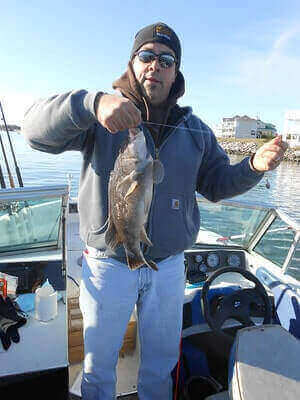
16. Tautog is notorious for stealing bait off the hook. Usually, you will feel a series of “taps” and then the bait is gone.
17. Crack the crab’s shell with the sinker before you send the rig to the bottom. This allows the scent to permeate the bottom and encourage a bite from the blackfish.
18. Braided line is a good choice for tautog fishing.

Tautog Setup
Tautog is a strong fighter and will easily take your tautog rig into the structure they reside in and break the line on the rod. Therefore, you have a stout medium-fast action, strong rod for tautog fishing.
A two-hook basic rig is one of the most popular tautog rig setups. Use green crabs as the bait for the two-hook basic rig. To have a good chance of pulling the blackfish out of the structures and wrecks while keeping a tight-set drag, use a 30 to 50-pound braid line with a heavy fluorocarbon or monofilament leader.
Use a rod with a length between 6 to 7 feet. The leader should be about 40 pounds with fluorocarbon or monofilament material. Additionally, the size of the bait rig hooks should be 4/0 and the jig hook size should be from 3/0 to 5/0 for jigs.
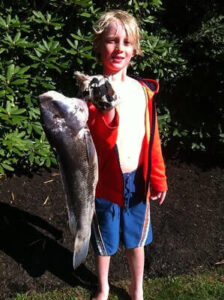
Best Tautog Baits
1. Green Crabs
Green crabs are highly effective bait for tautog fishing due to their natural appeal to these bottom-dwelling fish. Tautog are known for their preference for crustaceans, and green crabs are a favorite delicacy.
Anglers often use live or freshly killed green crabs rigged on a hook to entice tautog bites. The tough outer shell of the green crab provides durability against the tautog’s strong teeth, ensuring that the bait remains intact while on the hook.
Additionally, the scent and movement of the green crab in the water attract tautog, enticing them to strike. Whether fished on the bottom or suspended near rocky structures where tautog congregates, green crabs consistently prove to be a reliable bait choice for anglers targeting these prized gamefish.
2. “White Legger” Crabs
White legger crabs are a popular bait choice among anglers targeting tautog due to their availability and attractiveness to these bottom-dwelling fish. Tautog are known for their fondness for crustaceans, and white legger crabs offer a tempting meal option.
Anglers often use live or freshly killed white legger crabs rigged on a hook to entice tautog bites. The relatively small size of white legger crabs makes them suitable for tautog fishing rigs, allowing for easy presentation in rocky or structure-rich areas where tautog are commonly found.
The scent and movement of the white legger crab in the water serve as potent attractants, drawing tautog in for a strike. Whether fishing from a boat or shore, white legger crabs can be a reliable bait choice for anglers seeking to hook into these prized gamefish.
3. Asian Crabs
Asian crabs, also known as Asian shore crabs, are occasionally used as bait for tautog fishing, particularly in regions where they are abundant. While not as commonly used as other crab species like green crabs or white legger crabs, Asian crabs can still be effective in attracting tautog bites.
These crabs are opportunistic scavengers and often inhabit rocky or intertidal areas, making them accessible prey for tautog. Anglers may use Asian crabs either alive or freshly killed, rigged on a hook to entice tautog strikes.
Their smaller size compared to some other crab species makes them suitable for rigging on various tautog fishing setups, allowing for precise presentation around rocky structures where tautog often congregate. While not as widely recognized as other crab baits, Asian crabs can still serve as a viable option for anglers targeting tautog in areas where they are plentiful.
4. Clams
Clams are a popular and effective bait for tautog fishing due to their availability and attractiveness to the species. Tautog are known to feed on various crustaceans and mollusks, and clams present a natural and enticing option.
Anglers often use fresh or frozen clam strips, which are readily available at bait shops or can be harvested from beaches or tidal flats. The scent and texture of clams can quickly attract tautog, enticing them to feed.
Additionally, clams are durable and stay on the hook well, making them suitable for bottom fishing rigs commonly used when targeting tautog around rocky structures. Whether threaded onto a hook whole or cut into strips, clams provide a reliable bait option for anglers seeking to hook into these prized bottom-dwelling fish.
5. Oysters
Oysters are not typically used as bait for tautog fishing, as they are not as commonly associated with tautog feeding habits as other bait options like clams or crabs. Tautog is known to prefer crustaceans and mollusks such as crabs, shrimp, and various types of clams.
While tautog may consume oysters opportunistically if encountered, they are not typically sought after by anglers specifically targeting tautog. Instead, anglers tend to focus on bait options that closely mimic the natural prey of tautog and are more likely to elicit strikes from these bottom-dwelling fish.

The Bottom Line
Tautog is a favorite of many anglers as they put up a good fight, are difficult to catch, and make a tasteful plate. They are bottom feeders and hide in structures, reefs, rock pilings, wrecks, etc. In this article, we discussed fishing techniques to help you catch more tautog.
If you are interested in walleye, you can read the walleye fishing tips to learn how to catch more walleye. You can also read how to catch salmon, how to catch croaker, how to catch whiting, how to catch sheepshead, how to catch mackerel, and how to catch pompano.